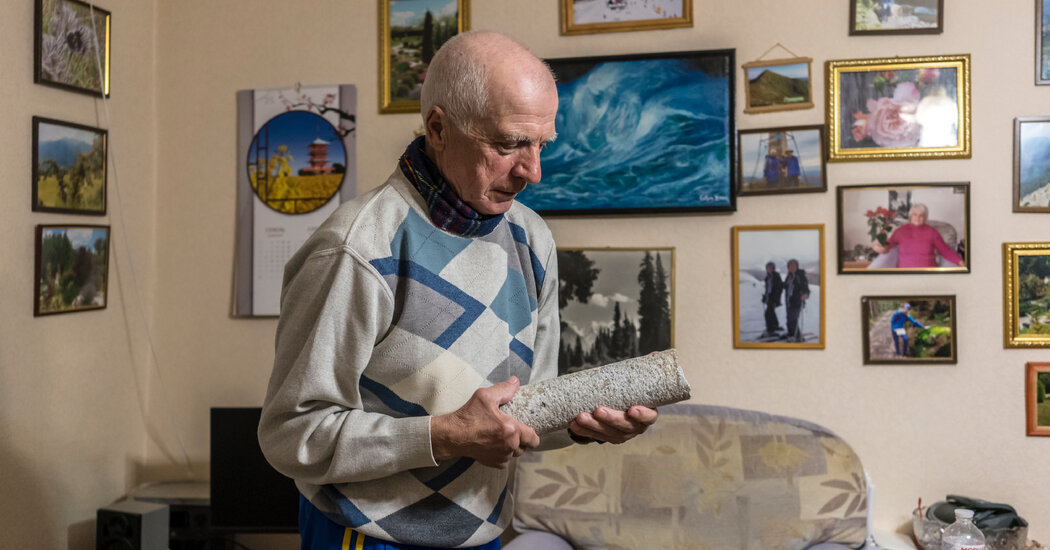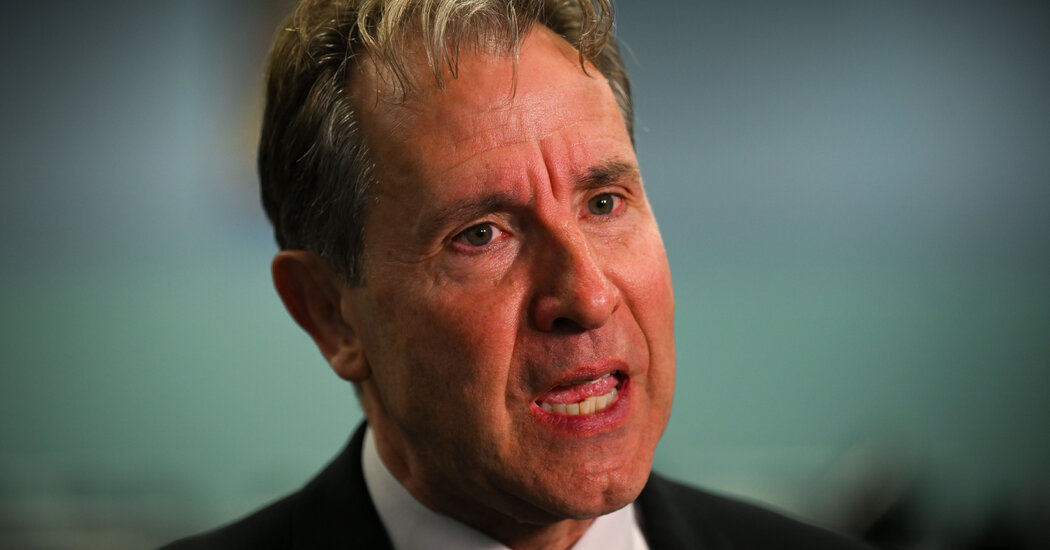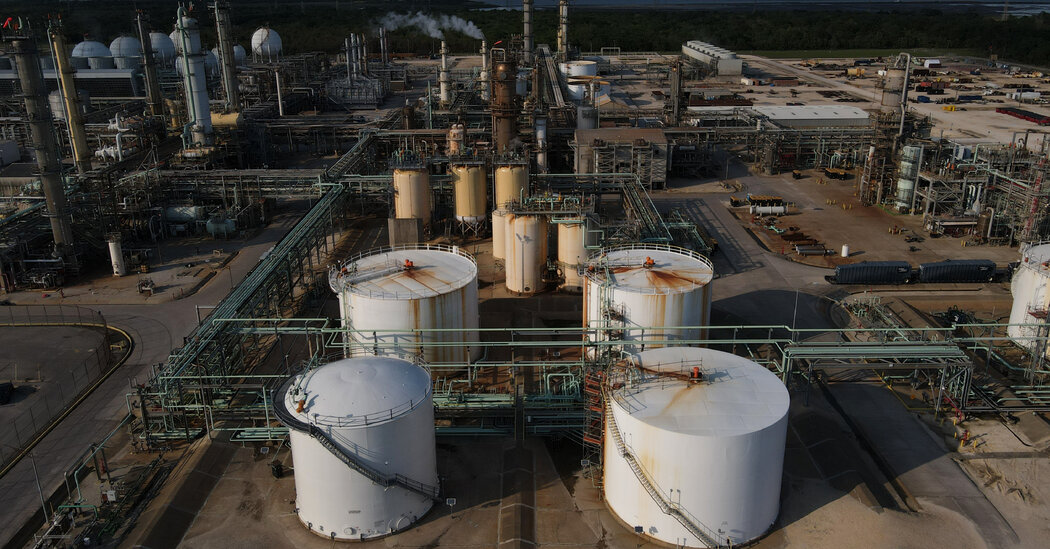A Ukrainian geologist was shopping in his local market recently for pork belly, lard, salmon and grapes when he heard the shouts of a man who seemed drunk, complaining about President Volodymyr Zelensky.
“Why didn’t Zelensky ask us before giving away our minerals to the Americans?” he yelled. A woman joined in: “The Americans are coming to take everything.”
The geologist, Volodymyr Savytskyi, 75, kept quiet. He is more hopeful about the potential minerals agreement that has dominated conversations — and exposed tensions — between his country and the United States.
“We just need to survive,” Mr. Savytskyi said. “I hope Trump won’t deceive us. I really hope he won’t. I believe the Americans should come, invest their money here, make their profit, but we should also get our fair share — our piece of the pie.”
In the central Ukrainian region of Kirovohrad, one of the country’s leading mining areas, reactions to the proposed deal are a mix of wary hopefulness, fatalism and anger. After years of trying to resist Russian influence and align with the West, many here reflexively view American investment positively, and are willing to use their natural resources to support the country’s most important ordeal, fending off Russia.
And yet, there are signs of growing skepticism about the terms and whether the United States, and specifically the Trump administration, can be trusted. Some people endorse the deal because they see Ukraine as having no other choice.
Ukrainian authorities say the country holds deposits of more than 20 critical minerals; one consulting firm valued them as being worth several trillion dollars.
The Trump administration is seeking future profits from these minerals, which it calls repayment for military aid the United States has given Ukraine since Russia invaded more than three years ago. In return, the U.S. would, in theory, continue to support Ukraine.
The deal has taken longer to reach than expected. An initial version fell apart at a disastrous White House meeting in late February. A new American proposal, made public in late March, is much more onerous for Ukrainians. Kyiv has said it would negotiate to improve the terms before signing a deal.
Critics derided it as a kind of blackmail. Some Ukrainians said it effectively steals resources from Ukraine while providing no security guarantees for the nation’s future.
Andriy Brodsky, who founded Velta, a leading private Ukrainian titanium company that could profit from a deal, said, “This is a win-win story if it’s done properly.”
But he stressed that any agreement should be fair to both countries. He said the deal should be a new Marshall Plan, which helped rebuild Europe after World War II while allowing American companies to profit. Six potential American investors had already approached Velta, wanting to join forces, Mr. Brodsky added.
Still, extracting minerals here is not like going to an A.T.M.: Although Velta started operations in 2003, it took until 2012 to start producing titanium from the large ilmenite deposits in Kirovohrad. Maps of Ukraine’s mineral deposits date back to Soviet times and aren’t necessarily reliable, experts say.
Environmentalists hope that U.S. investors might bring cleaner practices and better worker protections to the mines, but there have been no such guarantees.
Mr. Savytskyi, who grins to his ears when he talks about minerals, is a tour guide for everything below the surface here. He helped write an oft-cited paper in 2000 that outlines the region’s deposits of graphite, lithium, uranium and titanium, minerals that Mr. Trump is interested in. The Inhulska uranium mine, where he worked for about 23 years, is three miles from his front door.
The history of uranium extraction here, stretching back more than 60 years, shows how difficult it is to exploit minerals, even when there is a lot of interest.
In 1963, Soviet geologists drilled a well in the Inhul River valley, near the city of Kropyvnytskyi, to get water for a nearby plant. They found radiation. Core samples showed high levels of uranium.
It was considered a jackpot. The Soviet Union was in a nuclear arms race with the United States. Moscow quickly poured “a river of money” into developing that first mine, completing the work in just four years, said Mr. Savytskyi.
He arrived in the area in 1973 — a nerdy Cold Warrior, part of a secret geology research team — and started work on what was seen as a much richer uranium field beneath Kropyvnytskyi. If anyone asked what he was doing when he dug core samples in the city’s center, Mr. Savytskyi said he was looking for construction materials.
It took 10 years to develop that deposit, which together with the Inhulska mine became part of the state-run Eastern Mining and Processing Plant, now one of the world’s largest uranium mining facilities.
But in 1986, the Chernobyl disaster about 270 miles northwest — the largest nuclear accident in world history — dampened Moscow’s enthusiasm for Ukrainian uranium. Mr. Savytskyi’s research lost funding.
In 1996, five years after the Soviet Union collapsed, Mr. Savytskyi started working at the Inhulska mine. Over the years, it had its problems: The mine was not always profitable; workers were not always paid. For a time, nepotism and corruption were endemic, Mr. Savytskyi said. Workers often had health problems caused by radiation exposure.
Liudmyla Shestakova, who works with the environmental nonprofit Flora in Kropyvnytskyi, now a city of 220,000, took The New York Times on a tour around the Inhulska mine to look at the hills of leftover tailings that surround it.
This waste is mildly radioactive. When the wind blows or the rain pours, the results are predictably bad for the environment. Ukraine’s environmental rules lag behind the West’s: Asbestos wasn’t banned until 2017. Radon seems omnipresent.
Just outside Kropyvnytskyi, people fill jugs with water from a nearby spring that catches runoff from the mine. (They also take a constitutional cold-water dip in that spring, even on crisp February mornings.)
Ms. Shestakova, 65, said she generally believes U.S. investment might improve things, reflecting the durable good will Americans still have toward Ukraine, even with current tensions.
“If the investment comes through and it’s done responsibly — not with reckless mining practices — we fully support it,” she said.
But Ms. Shestakova voiced concern that Mr. Trump’s latest proposal is one-sided. She worries Ukraine will give away its natural resources with no guarantees for investments, environmental protections or the country’s security.
“It’s as if Ukraine gets nothing at all,” she said.
At a cemetery below a hill of uranium tailings, Nadiia Matsko, 65, recently visited the graves of family members; her husband, who worked underground as a miner, later died of diabetes. She was pragmatic about a deal with the Americans.
“If those minerals are lying there, and our people are not extracting them, and there is not any profit now, then if someone does it, and we get jobs and some percentage of the profit, then let them do it,” Ms. Matsko said, shrugging.
Maryna Vinnik, 64, immerses herself every morning in the spring that includes runoff from the mine. Ms. Vinnik is a librarian; her son is on the front lines. She said she has worried constantly over how the relationship with the United States has deteriorated.
“When we had strong support, everything felt different,” she said, standing barefoot on the snow, wrapped in a towel. “There’s a saying: ‘You can have this, but this also will take the shirt off your back.’ That’s how I view this agreement — as an unavoidable price we must accept. I don’t understand politics, but this feeling is heavy. In the past few days, I’ve been crying a lot and feeling deep sorrow.”
Mr. Savytskyi, who is a friend of Ms. Vinnik and believes her daily dips are probably harmless, still lives in the same apartment assigned to him by the Soviet Union about 40 years ago. Geology books like “Overseas Uranium Deposits” sit near his favorite chair, along with many of the minerals he holds dear: the core sample of granite, the smoky quartz from inside the Inhulska mine, the fluorite, the onyx, the gabbro, the glaucophane feldspar, all from deep in the ground of Ukraine.
His head was full of minerals, but he wasn’t oblivious to the war. A nearby missile strike had caused a power outage that morning. In 2022, he said, his family practically lived in the building’s basement because of shelling.
“That’s why I support this agreement,” he said. He added: “You understand that we are at war, and we must defend ourselves. We are willing to work with anyone who helps us.”




